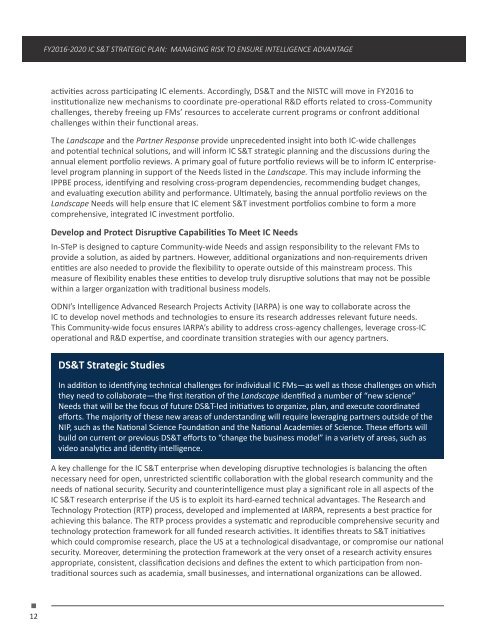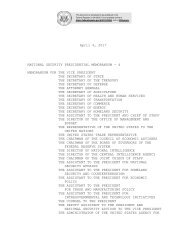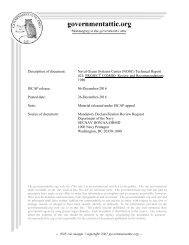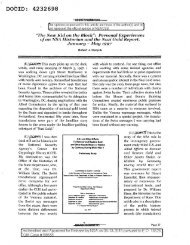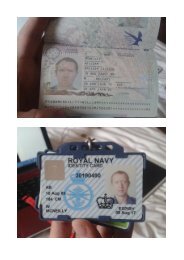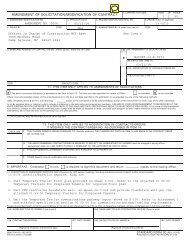IC S&T STRATEGIC PLAN
dni-sci-tech-2016-20-plan
dni-sci-tech-2016-20-plan
You also want an ePaper? Increase the reach of your titles
YUMPU automatically turns print PDFs into web optimized ePapers that Google loves.
FY2016-2020 <strong>IC</strong> S&T STRATEG<strong>IC</strong> <strong>PLAN</strong>: MANAGING RISK TO ENSURE INTELLIGENCE ADVANTAGEactivities across participating <strong>IC</strong> elements. Accordingly, DS&T and the NISTC will move in FY2016 toinstitutionalize new mechanisms to coordinate pre-operational R&D efforts related to cross-Communitychallenges, thereby freeing up FMs’ resources to accelerate current programs or confront additionalchallenges within their functional areas.The Landscape and the Partner Response provide unprecedented insight into both <strong>IC</strong>-wide challengesand potential technical solutions, and will inform <strong>IC</strong> S&T strategic planning and the discussions during theannual element portfolio reviews. A primary goal of future portfolio reviews will be to inform <strong>IC</strong> enterpriselevelprogram planning in support of the Needs listed in the Landscape. This may include informing theIPPBE process, identifying and resolving cross-program dependencies, recommending budget changes,and evaluating execution ability and performance. Ultimately, basing the annual portfolio reviews on theLandscape Needs will help ensure that <strong>IC</strong> element S&T investment portfolios combine to form a morecomprehensive, integrated <strong>IC</strong> investment portfolio.Develop and Protect Disruptive Capabilities To Meet <strong>IC</strong> NeedsIn-STeP is designed to capture Community-wide Needs and assign responsibility to the relevant FMs toprovide a solution, as aided by partners. However, additional organizations and non-requirements drivenentities are also needed to provide the flexibility to operate outside of this mainstream process. Thismeasure of flexibility enables these entities to develop truly disruptive solutions that may not be possiblewithin a larger organization with traditional business models.ODNI’s Intelligence Advanced Research Projects Activity (IARPA) is one way to collaborate across the<strong>IC</strong> to develop novel methods and technologies to ensure its research addresses relevant future needs.This Community-wide focus ensures IARPA’s ability to address cross-agency challenges, leverage cross-<strong>IC</strong>operational and R&D expertise, and coordinate transition strategies with our agency partners.DS&T Strategic StudiesIn addition to identifying technical challenges for individual <strong>IC</strong> FMs—as well as those challenges on whichthey need to collaborate—the first iteration of the Landscape identified a number of “new science”Needs that will be the focus of future DS&T-led initiatives to organize, plan, and execute coordinatedefforts. The majority of these new areas of understanding will require leveraging partners outside of theNIP, such as the National Science Foundation and the National Academies of Science. These efforts willbuild on current or previous DS&T efforts to “change the business model” in a variety of areas, such asvideo analytics and identity intelligence.A key challenge for the <strong>IC</strong> S&T enterprise when developing disruptive technologies is balancing the oftennecessary need for open, unrestricted scientific collaboration with the global research community and theneeds of national security. Security and counterintelligence must play a significant role in all aspects of the<strong>IC</strong> S&T research enterprise if the US is to exploit its hard-earned technical advantages. The Research andTechnology Protection (RTP) process, developed and implemented at IARPA, represents a best practice forachieving this balance. The RTP process provides a systematic and reproducible comprehensive security andtechnology protection framework for all funded research activities. It identifies threats to S&T initiativeswhich could compromise research, place the US at a technological disadvantage, or compromise our nationalsecurity. Moreover, determining the protection framework at the very onset of a research activity ensuresappropriate, consistent, classification decisions and defines the extent to which participation from nontraditionalsources such as academia, small businesses, and international organizations can be allowed.12


